The Featured Creatures collection provides in-depth profiles of insects, nematodes, arachnids and other organisms relevant to Florida. These profiles are intended for the use of interested laypersons with some knowledge of biology as well as academic audiences.
Introduction
Vespa mandarinia Smith holds the title for being the world's largest hornet. Commonly referred to as the northern giant hornet (formerly Asian giant hornet), Vespa mandarinia's unrivaled size and distinctive markings make it easily distinguishable from other Asian hornet species (Matsuura and Yamane 1990; Figure 1). This wasp's sting can be life-threatening to humans, and it can also decimate a number of insect colonies, most notably wild and managed honey bees (Matsuura and Sakagami 1973). Vespa mandarinia is native to Japan and can also be found established outside of its native range in several countries in Asia. In North America, a nest was removed and destroyed in 2019 in British Columbia. Within the United States, the first known account of detection of a Vespa mandarinia hornet was in Washington in fall 2019 (McGann 2019). In 2020 and 2021, four northern giant hornet nests were discovered and eliminated in northwestern region in the state of Washington. There have been no more detections or confirmations of this hornet’s presence in any other states to date.
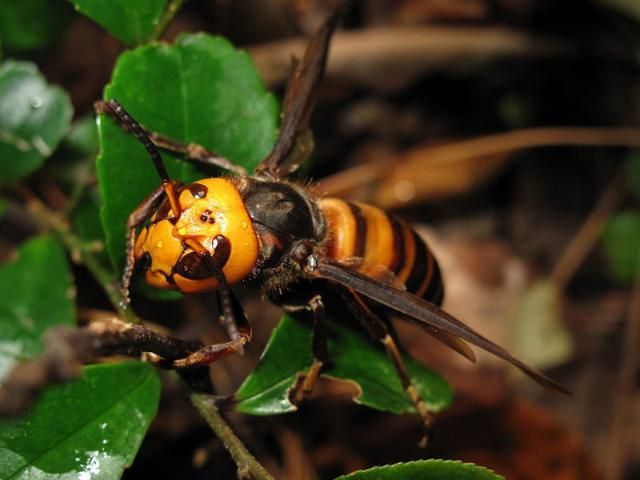
Credit: Yasunori Koide, Wikimedia commons
Synonymy
Vespa japonica Radoszkowski 1857
Vespa latilineata Cameron, 1903
Vespa sonani Matsumura, 1930
Vespa mandarinia bellona Smith, 1871
Vespa mandarinia magifica, Smith 1852
Vespa mandarinia nobilis, Sonan, 1929
Distribution
Vespa mandarinia is established in many parts of Asia including Thailand, China, Nepal, Russia, India and its native Japan (Tripodi and Hardin 2020). These hornets prefer to nest in temperate regions, including mountainous areas, but can also be found in some subtropical environments (Matsuura and Sakagami 1973). A colony of Vespa mandarinia was discovered in September 2019 in British Columbia, Canada. This was the first colony found in North America. The United States noted the first appearance of this hornet in early fall 2019. The first specimen was collected in December 2019 in Blaine, Washington; however, Vespa mandarinia is not considered established in any part of North America at this time (Tripodi and Hardin 2020, WSDA 2023). In 2020 and 2021, four northern giant hornet nests were discovered and destroyed in northwestern part of Washington State. There have been no more detections or confirmations of this hornet’s presence in any other states (Washington State Department of Agriculture).
Description
Vespa mandarinia individuals are large and robust wasps with several distinctive features that distinguish them from other similar species. The head is wider than other Asian hornet species, specifically above the mandibles and between the eyes (Figure 2). The front of the "face" above the mandibles (the clypeus) has a deeply scalloped edge, rather than being evenly rounded. The "cheeks" (genae) are pronounced on both sides of the head, making the head appear noticeably wide in full face view (Figure 2). The genae house the muscles needed to power the large mandibles that play a vital part in the ability of Vespa mandarinia to overpower prey (Matsuura and Sakagami 1973). Adult workers are often slightly shorter than 5.08 cm (2 inches) in length, whereas adult queens are close to 5.08 cm (2 inches) (Figure 3). Adults have an overall matte orange-yellow colored head (Figure 1). Banding on the abdomen is yellow and brown, with the last segment uniformly yellow (Matsuura and Yamane 1990; Figure 3).
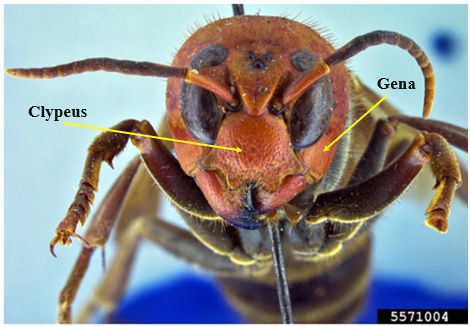
Credit: Allan Smith-Pardo, Invasive Hornets, USDA APHIS PPQ
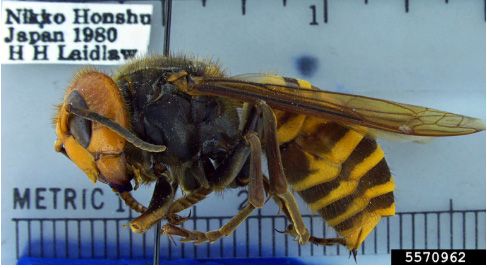
Credit: Allan Smith-Pardo, Invasive Hornets, USDA APHIS PPQ
The head, thorax and abdomen are stout and have varying densities of setae (hairs). In addition to compound eyes, these hornets, like other Hymenoptera, have ocelli (the three light-sensing organs between the eyes). The possession of the stinger distinguishes female reproductives (queen) and non-reproductive workers from the stingless males. The stinger is smooth and nearly a centimeter in length (Handwerk 2002). As is characteristic of all Hymenoptera, this hornet possesses 2 pairs of wings, with the forewing surpassing the body length of 5 cm (2 inches) (Figure 3).
The northern giant hornet introduction to the United States has caused confusion for identifications across the country with other hymenopterans with similar characteristics such as the Eastern Cicada Killer (Figure 4) (Roberts 2020). It is important to try to distinguish between these look-alikes to try to diminish any accidental misidentifications.
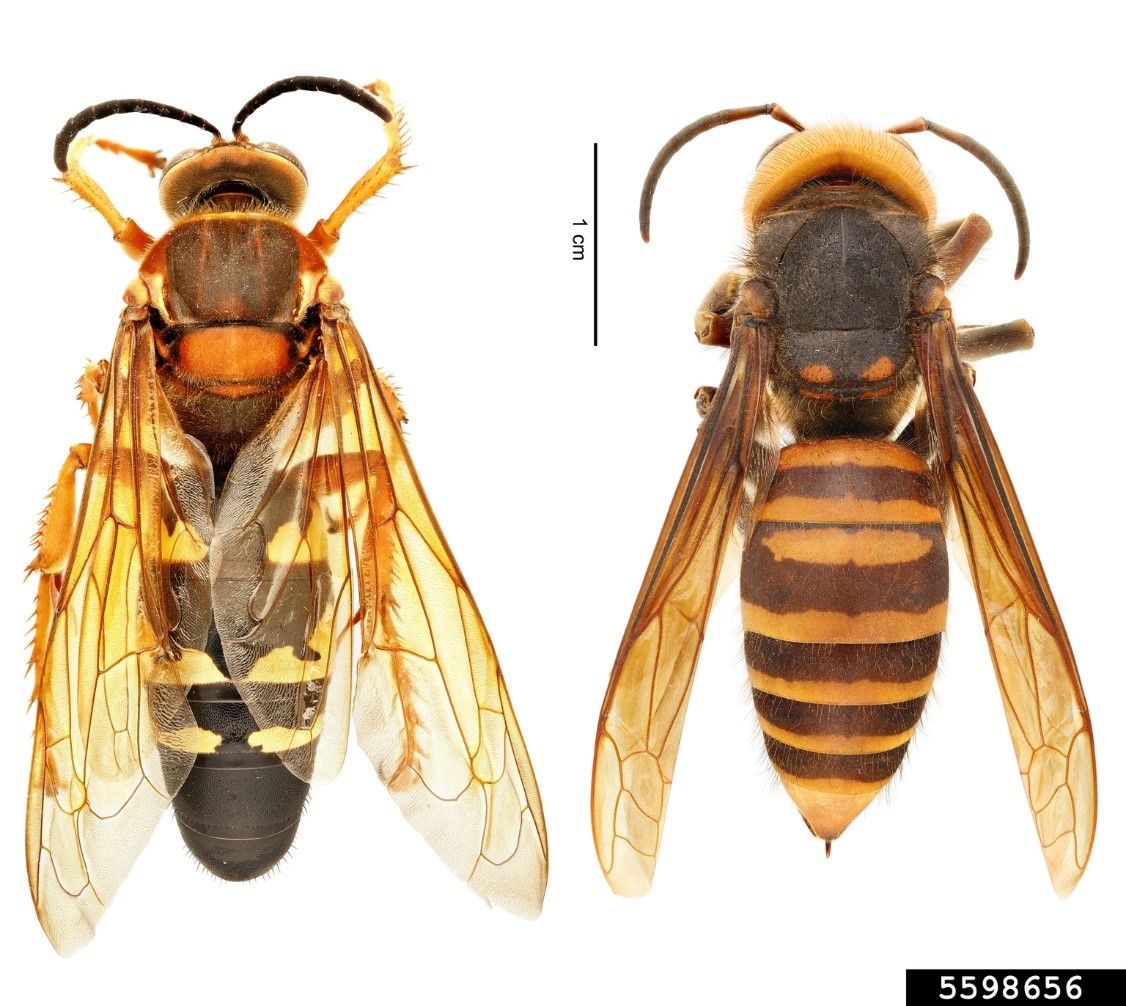
Credit: Hanna Royals, USDA APHIS PPQ ITP, Bugwood.org
Biology
All Vespa mandarinia colonies are established in the spring by mated queens after they have emerged from diapause (period of postponed development). These queens feed on tree sap for energy and first scout for a proper space to start a colony (Makino 2016). Once a queen has selected an adequate location, often in a cavity or hollow area near the roots of trees, she begins constructing the comb from woody materials gathered while foraging. These fibers are then manipulated into cells and the surrounding comb with her mandibles. To accommodate the growing colony, these hornets will excavate additional space by removing balls of soil with their mandibles (Matsuura and Yamane 1990).
The queen is solely responsible for the development and safeguarding of the colony. She continues to provide food and protection to her brood until workers begin to emerge (Matsuura and Yamane 1990). After worker emergence, the workers primarily take over these duties while the queen is dedicated to egg laying in the 1000 or more cells of its typically large nest (Matsuura and Sakagami 1973, Matsuura and Yamane 1990).
Larval Vespa mandarinia hornets develop through five larval instars (stages), during which time they are fed either bits of prey flesh or tree sap. After completing larval development, each individual pupates within the covered cell and remains in a cocoon for nearly 18 days (Matsuura and Yamane 1990). The colony size ranges greatly from 4 to 12 comb panels and as many as 3000 distinct cells (Matsuura and Yamane 1990). Each comb lies mostly horizontal, conforming to the available space. The nest cover is often unfinished, and consequently the last comb located at the bottom of the nest structure is exposed (Matsuura and Sakagami 1973). These brood cells can vary slightly in depth and width depending on whether they were constructed by the queen or workers. Worker cells have an average diameter of approximately 11 mm while both queen and male cells were 14 mm in diameter. The depth of these cells ranges from approximately 33 mm for workers to 42 mm for queens (Matsuura and Sakagami 1973).
Colonies grow during summer and into fall until a brood of reproductive females (new queens or gynes) and male hornets emerge around the end of October. These male hornets leave the nest and will wait outside nest entrances to mate with new queens emerging from nests. Once the new queens mate, typically with only one male, they begin to search for an ideal overwintering site in the soil, where they will remain for nearly seven months before starting their own colonies in the spring (Takahashi et al. 2004). In late fall, around mid-November, founding queens die, and the original colony quickly weakens as workers die off and are not replaced (Matsuura and Yamane 1990).
Predatory Strategies
Vespa mandarinia workers have a more extensive foraging range than other hornet species (Abe et al. 1991). They tend to attack prey located approximately two kilometers from the nest but have been noted to travel as far as eight kilometers in search of food (Matsuura and Yamane 1990). These hornets are very assertive when competing for resources during the spring months (Matsuura and Yamane 1990). For example, Vespa mandarinia nestmates will congregate around the sap supply on a tree and prevent other hornet species from feeding (Abe et al. 1991). Insect prey is a vital source of protein for the growing larvae in the nest and Vespa mandarinia most often preys on large beetle species. If accessible, this hornet also preys on honey bees and other Vespidae wasps among other insects (Matsuura and Yamane 1990).
Vespa mandarinia utilizes a pair of attack strategies to hunt other social insects. For example, the lone hunting mode involves a single hornet worker capturing one honey bee at a time outside the beehive entrance. The hornet kills the bee by detaching the head from the rest of the body at the thorax (Figure 5), then chews it into a gummy paste for transportation back to the nest where it is fed to larvae. The larvae chew on the prey and emit a liquid substance by the salivary gland that the adult hornets consume (Matsuura and Yamane 1990). Hornets take bees from multiple colonies rather than concentrating on one specific colony. This mode of hunting can inflict minor or major damage to the colonies, depending upon the honey bee species. Similarly, another invasive wasp species, Vespa velutina, attacks honey bee colonies in this way, weakening about 30% of honey bee hives (Monceau et al. 2014). The most famous mode of predation by this hornet, often referred to as a slaughter, it is extremely damaging to the prey colony (Matsuura and Yamane 1990).
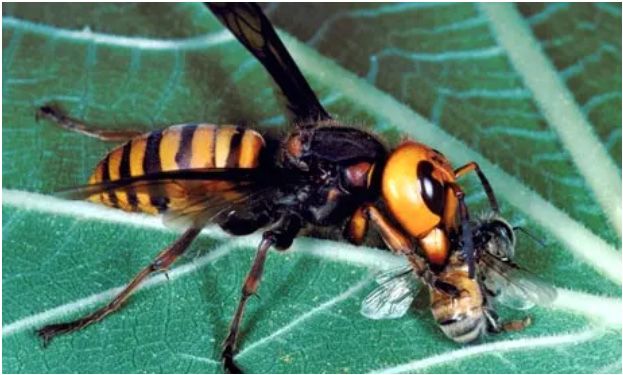
Credit: Dr. Scott Camazine
The slaughter strategy involves groups of 10 to 20 or more Vespa mandarinia nestmates staging a coordinated attack on a single colony by ripping multiple guard bees apart (typically at the head) with their mandibles until no individuals remain to defend the nest entrance (Figure 3). An entire honey bee colony of about 30,000 individuals can be destroyed in several hours with the remains of those workers being left in and around the hive (Matsuura and Yamane 1990, Matsuura and Sakagmai 1973). If there are still survivors come nightfall, the hornets will retire to their nest and reappear the next morning to continue their attack until occupation is complete. Once the majority of the bee workers are destroyed and unable to defend the nest, the hornets retrieve the bee larvae and pupae to feed their own young (Matsuura and Sakagmai 1973).
A depiction of this process can be viewed in the National Geographic "Hornets from Hell" video (Handwerk 2002). These types of invasions typically occur in the late summer months when the hornet colonies have produced many workers (Matsuura and Sakagami 1973).
European honey bees, Apis mellifera, are practically defenseless against this predator as they have not evolved strategies to defend their colonies. Honey bee stings are ineffective at deterring the hornet as Vespa mandarinia's robust cuticle is not susceptible to these stings (Tan et al. 2016). Asian honey bees, Apis cerana, have evolved a stronger group tactical technique because of their historical co-existence with Vespa mandarinia. The bees communicate to each other to begin surrounding (or "balling") the hornet in order to raise their group temperature to approximately 46°C (Figure 6), which is high enough to kill the hornet but not kill themselves (Egelie et al. 2015, Ugajin et al. 2012).
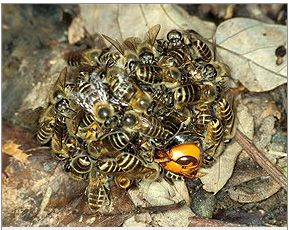
Credit: Dr. Masato Ono
Medical Significance
Similar to other stinging insects, they generally cause risks to humans when protecting their nest or another provocation (WSDA 2023), although this hornet's strong defensive nature intensifies the potential risk for serious medical complications in humans. Vespa mandarinia has been associated with severe responses in those who are not considered anaphylactic or allergic (Yanagawa et al. 2007). It is estimated that approximately 40 people die from the stings each year (Yanagawa et al. 2007). These deaths have been contributed to kidney failure, anaphylactic shock, heart attacks, and multiple organ failure, often from multiple stings (Yanagawa et al. 2007). During a four-month period in 2013, Vespa mandarinia caused 42 deaths and 1,675 injuries in China. In the cases of injuries that lead to hospitalization, it often took about 30 days for recuperation (Liu et al. 2016). Further, these hornets can cause scars from stinging that can endure for some years (Matsuura and Yamane 1990).
Management and Outlook
Management of Vespa mandarinia is quite difficult because of the stinging risk and lack of accessibility to the nests. In the past, Japanese inhabitants have used physical elimination as well as chemicals to kill and reduce Vespa mandarinia colonies, though they are difficult to locate and kill below ground. Insecticides such as ready-to-use aerosols and concentrates are utilized by the US Department of Defense in efforts to control other species of oriental hornets (APHC). Some beekeepers have taken to using mechanical devices, including specially designed screening, to assist with defending and protecting the bees at the hive entrances (Matsuura and Yamane 1990). While there are homemade devices used by some beekeepers in Europe, there are also commercial products, such as false bottom boards that trap hornets attempting to invade managed honey bee hives.
In response to the presence of the northern giant hornet, the Department of Agriculture in Washington state (WSDA) and the United States Department of Agriculture – Animal and Plant Health Inspection Service (Plant Protection and Quarantine) developed new pest response guidelines for Vespa mandarinia (Tripodi & Hardin 2020). Monitoring for the northern giant hornet begins each spring by using a combination of citizen science, trapping and tracking. In 2021, a telemetry tag was affixed to hornets to help scientists track nests and therefore complete nest eradication (Lucik 2023 May). While no hornets were detected in 2022, the WSDA has plans to utilize unmanned aircraft systems to aid in tracking hornet tags as well as employing over 1000 traps in the area where the previous nests were found (Lucik 2023 June). All data pertained to the northern giant hornet response can be found on the WSDA website.
This species has a history of notorious impacts on honey bee colonies, particularly managed Apis mellifera (Matsuura and Sakagami 1973). As honey bees play a significant role in the pollination of many crops, the establishment of Vespa mandarinia in the United States could have a severe impact on agriculture and the economy. While the effects of the northern giant hornet on bees is the primary concern, public fear of stings from these large insects is also significant, if outsized relative to the incidence of stings. Continuous monitoring and subsequent elimination of any discovered colonies is paramount to preventing Vespa mandarinia establishment and spread in new regions.
Selected References
Abe T, Tanaka Y, Miyazaki H, Kawasaki YY. 1991. Comparative study of the composition of hornet larval saliva, its effect on behavior and role of trophallaxis. Comparative Biochemistry and Physiology 99:79–84. https://doi.org/10.1016/0742-8413(91)90079-9
Army Public Health Center (APHC). Oriental Hornets. Fact Sheet 18-074-0616. (27 October 2019)
Catalogue of Life: 2019 Annual Checklist. 2019. Species Details: Vespa mandarinia Smith, 1852. (26 June 2019)
Egelie AA, Mortensen AN, Gillett-Kaufman JL, Ellis JD. 2015. Apis cerana Fabricius (Insecta: Hymenoptera: Apidae). UF/IFAS Department of Entomology and Nematology, Featured Creature, EENY 616. (29 September 2019)
Handwerk, B. 2002. "Hornets from Hell" Offer Real-Life Fright. National Geographic News. (11 January 2020)
Liu Z, Li X, Guo B, Li Y, Zhao M, Shen H, Zhai Y, Wang X, Liu T. 2016. Acute interstitial nephritis, toxic hepatitis and toxic myocarditis following multiple Asian giant hornet stings in Shaanxi Province, China. Environmental and Preventative Medicine 21:231–236. https://doi.org/10.1007/s12199-016-0516-4
Lucik S. 2023 May. “Experts Collaborate, Initiate and Succeed–Times Four." United States Department of Agriculture, Animal and Plant Inspection Service, Plant Protection and Quarantine. Plant Protection Today. (20 July 2023)
Lucik S. 2023 June. “Leveling the Playing Field with a New Unmanned Aircraft System." United States Department of Agriculture, Animal and Plant Inspection Service, Plant Protection and Quarantine. Plant Protection Today. (20 July 2023)
Makino S. 2016. Post-hibernation ovary development in queens of the Japanese giant hornet Vespa mandarinia (Hymenoptera: Vespidae). Entomological Science 19: 440–443. https://doi.org/10.1111/ens.12205
Matsuura M, Sakagami SF. 1973. A bionomic sketch of the giant hornet Vespa mandarinia, a serious pest for Japanese apiculture. Journal Faculty of Science 19: 125–162.
Matsuura M, Yamane S. 1990. Biology of the Vespine Wasps. Berlin. Springer-Verlag, pp. 1–323.
McGann C. 2019. Pest Alert: Asian giant hornet. Washington State Department of Agriculture. (1 April 2020)
Monceau K, Bonnard O, Thiéry D. 2014. Vespa velutina: A new invasive predator of honeybees in Europe. Journal of Pest Science 87: 1–16.
Ono M, Igarashi T, Ohno E, Sasaki M. 1995. Unusual thermal defense by a honeybee against mass attack by hornets. Nature 377: 334–336. https://doi.org/10.1038/377334a0
Roberts J. 2020. Imposter Identities: “Murder Hornets” vs. Eastern Cicada Killers. UF/IFAS Extension Orange County. (20 July 2023).
Royals H. 2020. Museum Collections: Hymenoptera, USDA APHIS PPQ, Bugwood.org (23 July 2023).
Smith-Pardo A. 2018. Invasive Hornets, USDA APHIS PPQ, Bugwood.org. (27 October 2019)
Takahashi J, Akimoto S, Martin SJ, Tamukae M, Hasegawa E. 2004. Mating structure and male production in the giant hornet Vespa mandarinia (Hymenoptera: Vespidae). Applied Entomology Zoology 39: 343–349. https://doi.org/10.1303/aez.2004.343
Tan K, Dong S, Li X, Liu X, Wang C, Li J, Nieh JL. 2016. Honeybee inhibitory signaling is tuned to threat severity and can act as colony alarm signal. PLoS Biology 14: e1002496. https://doi.org/10.1371/journal.pbio.1002423
Tripodi A, Hardin T. 2020. New Pest Response Guidelines. Vespa mandarinia Asian Giant Hornet. United States Department of Agriculture. (13 April 2020)
Ugajin A, Kiya T, Kunieda T, Ono M, Yoshida T, Kuno T. 2012. Detection of neural activity in the brains of Japanese honeybee workers during the formation of a "Hot Defensive Bee Ball". PLoS One 7: e32902. https://doi.org/10.1371/journal.pone.0032902
Washington State Department of Agriculture (WSDA). 2023. Invasive Hornets. (23 July 2023).
Washington State Department of Agriculture (WSDA). 2023. Northern Giant Hornets and Human Health. (23 July 2023).
Yanagawa Y, Morita K, Sugiura T, Okada Y. 2007. Cutaneous hemorrhage or necrosis finding after Vespa mandarinia (wasp) stings may predict the occurrence of multiple organ injury: A case report and review of literature. Clinical Toxicology 45: 803–807. https://doi.org/10.1080/15563650701664871